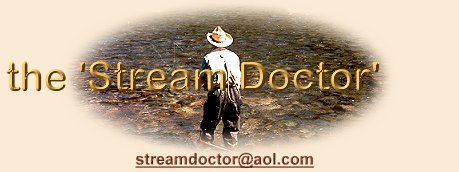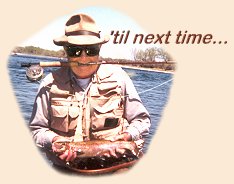
| ||
|
April 11th, 2005
|
|
Q. Just found your column and it is truly amazing! I have a lot of rust to shake off as I haven't had a chance to do much fly-fishing as an adult. I am hoping to do more now, and I was hoping to ask a question of you. I have loved to stream and creek fly-fish my entire life, but I have never become proficient and knowledgeable about real stream mechanics. I realize now how important it is to learn and really understand entomology. If you could suggest one or two books to a "novice" fly-fisherman that would really give him a strong hold on understanding fly-fishing entomology, which books would you recommend? The only thing I have learned in life is how much there is to learn. It is overwhelming. I really want to be a better fly-fisherman. I catch fish when I go out because I ask someone what pattern I should be using. If that doesn't work, I go through to my stable of elk-hair caddis, woolly buggers, etc., and eventually get some fish. Every once in a while I find the right pattern and it is fish after fish. I guess the object is no longer simply to catch fish, but to really figure out what the hell I am doing. I want to understand why I am catching fish, and become proficient at understanding what is going on above and below the water. I want to be able to walk out and read the signs - which I am sure are everywhere like huge billboards of information, but I currently don't see them because I don't have the foundation and know what to look for. I want to be a consistent producer based on my knowledge of streams and bugs. What books would you recommend? I want to know the important bugs, their life-cycles and stages, their habitat, and be able to RECOGNIZE them. I need the building blocks. Thank you very much, Paul Henry
A.
Thanks for the kind words about the column, Paul.
Since I don't know what part of the country
you fish, I'm going to have to be pretty generic
in terms of recommending books on entomology. It
also sounds like you're asking about books with
two kinds of information:
(2) books on entomology. At least that's how I'm
going to frame my response; hope it works for you.
Streams: Their Ecology and Life, by
Colbert E. Cushing and J. David Allan.
2001, Academic Press, ISBN 0-12-050340-9. 366 pp.
Yes, this looks like I'm being self-serving, but
it fits the bill of what you want. Dave and I wrote
the book with the specific idea of conveying the
basics of stream ecology to lay readers. It will
tell you all the basic principles of the physical,
chemical, and biological characteristics of streams
and has chapters on all major plant and animal
groups found in and around streams. The chapter
on insects will more than fill the bill for what
you want to know about life-histories – plus it
has a lot of nice colored photos of many insects.
There actually is one other book that somewhat
parallels ours, written by a good friend, but
I'm not sure of it's availability; that's why
I said that ours was the only one on the market.
It is:
Wildstream, by Thomas F. Waters.
2000. Riparian Press. ISBN 0-9637616-1-7.
608 pp.
Tom's book is much longer than ours, his emphasis
is a bit different, and it has no color.
These are the only two books that I would
recommend for someone wanting to learn about
the basic ecological characteristics of
streams and their watersheds without getting
too technical. If it turns out that you want
to get more technical, let me know and I'll
send you titles for these.
Now for some books that will help you recognize
the different kinds of insects. Again, this can
range from the fairly non-technical to sophisticated
identification books with taxonomical keys to
all insects. I'm assuming you want the former,
so my first choice would be:
Aquatic Entomology, by W. Patrick
McCafferty. 1981, Jones and Bartlett Publ.
ISBN 0-86720-017-0. 448 pp.
This book, although quite bulky, has a lot of
good line drawings, half-tones, and beautiful
colored paintings of many aquatic insects,
both immatures and adults. It also has keys
to help in identification. It has some ecology
in it.
Another small book that is restricted
geographically but would still be good
for general identification is:
An Illustrated Guide to the Mountain Stream
Insects of Colorado, 2nd Ed., by
James V. Ward, Boris C. Kondratieff, and Robert
E. Zuellig. 2002, Univ. Press of Colorado, ISBN
0-87081-653-5. 219 pp.
It has a few pages of general ecology but is
mostly composed of keys for identification of
the Colorado stream insects with black-and-white
line drawings.
Now if you really decide that you want to get
into insect identification and the science of
aquatic entomology, the book you want is:
An Introduction to the Aquatic Insects
of North America, 3rd Ed., Richard W.
Merritt and Kenneth W. Cummins (eds.). 1996.
Kendall Hunt Publ. Co., ISBN
0-7872-1761-1. 862 pp.
Ken tells me that a new edition of this book
is due any day. It contains chapters by various
authorities on the different insect groups,
keys to the genus level, much ecological and
biological information on all groups; in short,
it is the choice of professionals looking for
broad coverage of all insect groups.
The above books, with the exception of the
Colorado book, are fairly general and applicable
to any part of the country. I'm sure that you
could find books in your local fly shops that
might be more specific on insects in your area.
I know there are several for the western U.S.;
there are guides to western hatches, streamside
identification booklets, and on and on. I'm sure
you can find something similar and more specific
if you fish in the east.
My overall recommendation to you, given your
original questions, would be to start with
either Streams: Their Ecology and Life
or Wildstream to get a good
foundation on how streams work and then go on
to some books (general or regional) that teach
you about insects. You may find enough about
insects in Streams or Wildstream to satisfy you.
PS: My previous columns of January 19, 2004 and
December 16, 2002 contain further information
on similar books, some of which are described
above; you can access these through my current column. ~ Bert
If you have a question, please feel free to contact me.
|
| If you would like to comment on this or any other article please feel free to post your views on the FAOL Bulletin Board! |
 The 'Stream Doctor' is a retired professional stream ecologist and
author, now living in the West and spending way too much time
fly-fishing. You are invited to submit questions relating to
anything stream related directly to him for use in this Q & A Feature
at
The 'Stream Doctor' is a retired professional stream ecologist and
author, now living in the West and spending way too much time
fly-fishing. You are invited to submit questions relating to
anything stream related directly to him for use in this Q & A Feature
at